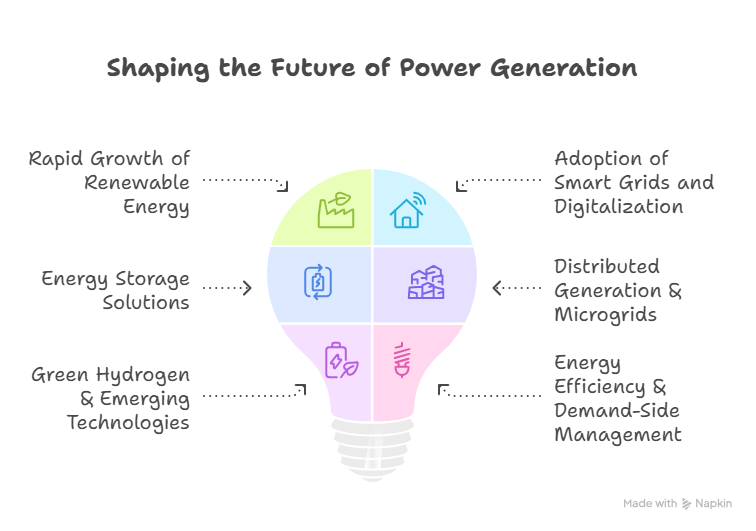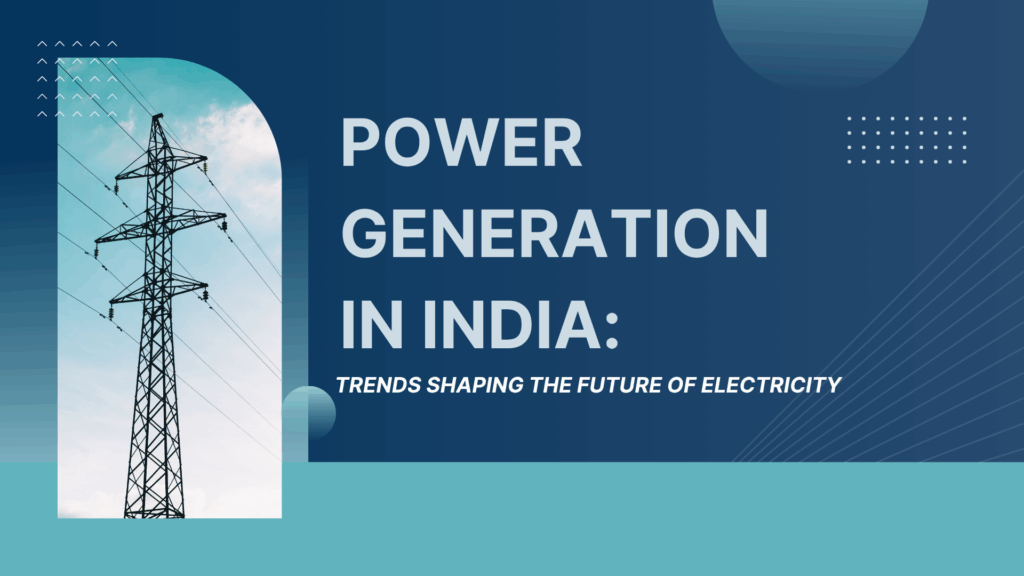India is undergoing a transformational shift in its power generation landscape. With growing energy demands, climate commitments, and technological advancements, the country is embracing new trends to ensure reliable, sustainable, and affordable electricity.
This article explores the current state of power generation in India, emerging trends, challenges, benefits, and future opportunities for businesses, policymakers, and energy stakeholders.
Current Landscape of Power Generation in India
India has a diverse energy mix, including:
- Thermal power: Coal, natural gas
- Renewable energy: Solar, wind, hydro, biomass
- Nuclear energy
Key facts:
- India ranks third globally in electricity production.
- Renewable energy capacity is growing rapidly, with ambitious targets under the National Solar Mission and other initiatives.
- Grid expansion and modernization are essential to meet the rising electricity demand.
Emerging Trends in Power Generation
- Rapid Growth of Renewable Energy
Renewables, especially solar and wind, are the backbone of India’s energy transition.
Key Drivers:
- Falling costs of solar panels and wind turbines
- Government incentives and policies
- Corporate renewable procurement commitments
Impact: Reduces carbon footprint, enhances energy security, and supports sustainable development goals (SDGs).
- Adoption of Smart Grids and Digitalization
Smart grids leverage IoT, AI, and data analytics to improve efficiency, reduce losses, and enable real-time monitoring.
Benefits:
- Enhanced grid stability
- Better demand-supply management
- Reduced operational costs
- Energy Storage Solutions
With the rise of intermittent renewable sources, battery storage and pumped hydro storage are gaining traction.
Advantages:
- Ensures consistent power supply
- Facilitates peak load management
- Reduces dependency on fossil fuels
- Distributed Generation & Microgrids
Decentralized energy systems, including rooftop solar and localized microgrids, are empowering communities and industries.
Benefits:
- Reduces transmission losses
- Enhances energy access in remote areas
- Supports resilience during grid failures
- Green Hydrogen & Emerging Technologies
Green hydrogen, produced via electrolysis powered by renewables, is emerging as a clean fuel for power generation and industry.
Impact:
- Reduces carbon emissions from thermal plants
- Opens avenues for export and industrial applications
- Complements renewable integration into the grid
- Energy Efficiency & Demand-Side Management
Programs aimed at efficient appliances, industrial processes, and behavioral interventions are helping balance demand and reduce overall energy consumption.
Benefits:
- Lower electricity bills
- Reduced environmental impact
- Optimized resource utilization

Benefits of Evolving Power Generation Trends
- Sustainability: Cleaner, renewable energy reduces carbon footprint.
- Energy Security: Diversified sources ensure reliable electricity supply.
- Economic Growth: Renewable sector creates jobs and attracts investments.
- Technological Advancement: Adoption of smart grids, storage, and AI-driven solutions enhances efficiency.
- Rural Development: Distributed energy systems improve electricity access in underserved regions.
Challenges in India’s Power Sector
- Infrastructure Constraints: Aging thermal plants and transmission systems require upgrades.
- Intermittency of Renewables: Solar and wind output can be inconsistent.
- Financing & Investment Needs: Large-scale projects require significant capital.
- Regulatory Hurdles: Policy changes and delays can impact project execution.
- Skill Gap: Shortage of trained professionals in emerging energy technologies.
Final Words
India’s power generation sector is entering a dynamic phase, shaped by renewables, digitalization, and innovative technologies. Businesses, policymakers, and energy professionals who embrace these trends will benefit from sustainable growth, energy security, and environmental impact reduction.
At Ebullient, we empower organizations and professionals through energy-focused training programs, strategic workshops, and practical insights to navigate India’s evolving power landscape. Our programs help teams understand trends, adopt best practices, and drive actionable results.
Explore how Ebullient can help your organization stay ahead in the energy transition at https://ebullient.in. Together, let’s power a sustainable future.
FAQ – Power Generation in India
- What is the current energy mix in India?
India relies on coal, natural gas, hydro, nuclear, and rapidly growing renewable sources like solar and wind. - Why are renewables important for India?
They reduce carbon emissions, enhance energy security, and provide sustainable growth opportunities. - What role do smart grids play in power management?
Smart grids use AI, IoT, and analytics to optimize supply, reduce losses, and improve reliability. - How is energy storage transforming the sector?
Battery and hydro storage stabilize intermittent renewable output, ensuring consistent electricity supply. - What challenges does India face in the power sector?
Infrastructure gaps, renewable intermittency, financing needs, regulatory hurdles, and skill shortages are key challenges.



